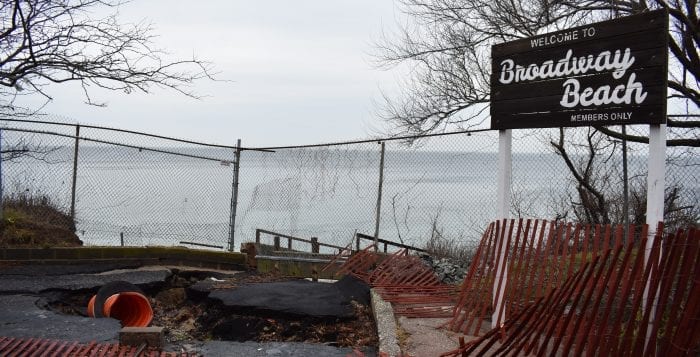Brookhaven to Add Revetment/Drainage to Rocky Point Beach
Town of Brookhaven highway officials are completing the final FEMA-funded project to shore-up Brookhaven shoreline following Hurricane Sandy, the storm that wrecked Long Island’s coastline nearly 7½ years ago.
At its Dec. 5 meeting, the Town Board voted unanimously to enter into an agreement with the North Shore Beach Property Owners Association to go in and add a new stone revetment and bulk heading to halt erosion, but also adding an interceptor unit at the end of Broadway in Rocky Point, one that town Highway Superintendent Dan Losquadro (R) said will treat runoff for sediment and organic material before it outfalls into Long Island Sound. The project is expected to start early in 2020 and finish by Memorial Day. Losquadro said he doesn’t expect any major difficulties in construction.
“The storm presented an opportunity — building it stronger so it doesn’t get damaged later,” he said.
While the town only got federal approval for the project last year, the costs comes in at about $1.2 million, with 90 percent being taken up by Federal Emergency Management Agency funds secured in part, Losquadro said, by U.S. Rep. Lee Zeldin (R-NY-1). The last 10 percent, or $120,000, comes from the town’s highway budget as a capital project.
The interceptor unit is a large concrete drum that will lie somewhere under the road.
Losquadro said the town has been involved with 10 other Sandy-related projects on the North Shore since the storm hit, which not only look to repair storm damage but help prevent future injury to the shoreline. The town has spent around $12 million in FEMA and their own funds with these construction projects, he said.
Many of the roads lying nearest to the shore are named some combination of “gully” and “landing,” with many of these streets being low-lying areas where water naturally congregates. Where once they were dirt and gravel, paving them has led to drainage complications. Much of the land is privately owned, such as the case of the end of Broadway and the connected beachfront.
“There’s been a number of homeowner associations we’ve had to work with,” the highway superintendent said. “A lot of these drainage easements go through private properties.”
A representative of the NSBPOA did not return calls for comment from their clubhouse.







